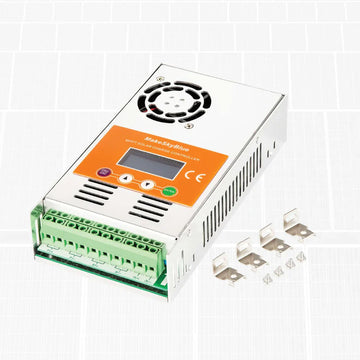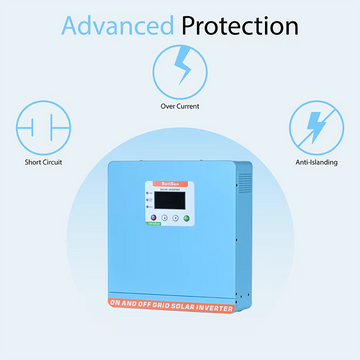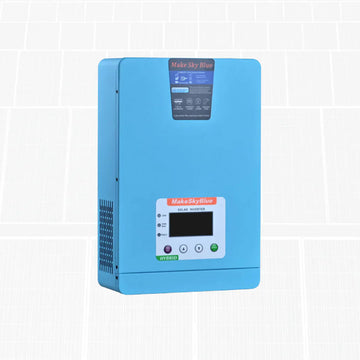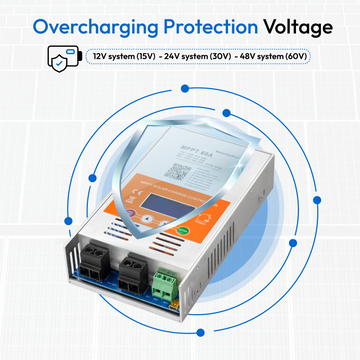There is no need to start with solar energy. Besides, selecting the appropriate equipment is the key to the performance of the system. A solar charge controller 10 amp is the protector of your battery which does not allow it to be destroyed and at the same time gives maximum efficiency.
This guide describes the whole lot about these small controllers. You will also get to know how they operate, which systems they serve and why they are the ideal match to smaller solar systems. Powering a cabin, RV, or boat, you are able to create a dependable solar system, which is why it is crucial to comprehend this vital element in the process.
What Is a 10 Amp Solar Charge Controller?
A solar charge controller of 10 amp controls the circulation of electricity between batteries and solar panels. Thus, it averts overcharging when the sun is shining and inhibits backward current flow at night. These gadgets regulate battery voltage and charge the batteries at the best rate to keep them in an optimum state of health.
The 10 ampere is the maximum current that the controller will be safe to operate with. This, therefore, renders it suitable to systems which have up to 120-140 watts of solar panels in 12V systems. In addition, the controller is a smart switch, which activates power when required and deactivates it when not in use.
The majority of its units are auto voltage detecting (12V and 24 V). In the meantime, higher models have LCD displays with real-time information on charging time, battery voltage, and total power generated.
What Is the Operation of This Controller?
The following knowledge will make you appreciate its functionality. To begin with, the controller takes the readings of the incoming voltage to your solar panels. Then it compares this voltage with the energy charge level in your battery.
The controller permits the maximum current to be passed during the bulk charging stage to rapidly charge depleted batteries. Later on it goes into absorption mode as the battery reaches full capacity. Lastly, the float mode keeps the battery at 100 per cent without charging it to dead.
The pulse-width modulation technology can regulate the rate at which the batteries are charged according to the state of the batteries thus making the process more advanced than the on-off switching. Thus, batteries have increased life span and lifecycle performance.
Temperature is also measured by the controller so as to avoid overheating. It also offers guard against short circuiting, reverse polarity and overvoltage.
What Can You Power with 10 Amps?
Determining system capacity helps set realistic expectations. A 10 amp solar charge controller supports various applications depending on your battery bank size and daily energy consumption.
Typical Power Applications
Small solar setups with this controller can reliably power several devices:
-
LED lighting systems drawing 5-20 watts
-
Mobile phone and tablet charging stations
-
Small 12V refrigerators consuming 30-50 watts
-
Radio communication equipment
-
Security cameras and monitoring systems
-
Water pumping for gardens or livestock
However, the total daily energy depends on your solar panel wattage and available sunlight hours. Therefore, planning your system requires calculating both production and consumption carefully.
Battery Bank Compatibility
The controller is suitable for use with battery banks of 20Ah to 200Ah. But as the batteries are larger, the charging will take more time. The best rates of charging are in the range of C/12 and C/8 for the well-being of the battery, which means the 100Ah battery prefers the 8-12 amps.
Thus, a 10 amp solar charge controller is the right one for an 80-120Ah battery bank that has a balanced performance.
What Are the Reasons to Choose This Size for Small Systems?
The correct controller size prevents the system from underperforming and causing unnecessary financial losses. 10-amp controllers are the most appropriate for small setups due to many reasons.
Users who are on a tight budget appreciate the low price in comparison with the higher-capacity models. On top of that, these controllers take up very little space. Thus, it is really easy to install them in cramped areas like RVs and boats.
The power output of the solar panel is arranged to match the typical configuration of small solar panels. For instance, a single 100-watt panel produces around 8-9 amps in good conditions. As a result, the 10-amp level is optimal and offers extra capacity without any extra cost.
When system components are in harmony, the reliability of the whole system increases. In addition, minor satellite systems produce reduced heat, which in turn makes the cooling system requirements smaller and extends the component work life.
Essential Highlights to Look- for in Controllers
Controllers do not operate at the same rate. In this sense, comparing features is a very effective way of identifying the quality of units that will meet your personal needs.
Security systems
The primary safeguard that must be employed in all solar power systems is safety with overcharge protection, temperature compensation, short-circuit protection, and reverse polarity safeguards. Meanwhile, it adjusts the charging process by determining the amount of green electricity that is available.
Communication and display
LCI displays systems for monitoring electricity generation and displays information on electricity flow through the system. As a consequence, users will be able to discover the problems quickly and also document the energy production daily. In addition, the latest variants now come with wi-fi capabilities for monitoring
Batteries' compatibility
Quality controllers can use different battery types like flooded lead-acid, AGM, gel, and lithium batteries. This way, you will manage your battery replacement and server options on your system more efficiently.
Charging protocols
Depending on the technology, a battery may be powered either by PWM or MPPT. On the other hand, PWM or MPPT will determine the overall efficiency of the system, whereas MPPT will produce energy 20-30% higher than it would in some conditions.
Comparison Between PWM and MPPT Controllers
Understanding technology differences helps inform purchasing decisions. The table below highlights key distinctions between these common controller types.
|
Feature |
PWM Controller |
MPPT Controller |
|
Efficiency |
70-80% |
95-98% |
|
Price Range |
Lower cost |
Higher investment |
|
Best Application |
Small systems |
All system sizes |
|
Panel Voltage Matching |
Must match battery |
Flexible voltage |
|
Energy Harvest |
Standard output |
Maximized output |
|
Complexity |
Simple design |
Advanced electronics |
Nevertheless, for systems under 200 watts, PWM controllers offer excellent value. Conversely, MPPT technology becomes more cost-effective in larger installations.
Installation Tips for Safe Operation
Proper installation ensures maximum performance and longevity. Therefore, following best practices prevents common problems that reduce system effectiveness.
First, always connect the battery before attaching solar panels. This sequence prevents voltage spikes that damage controller electronics. Similarly, disconnect panels before removing the battery.
Mount the controller in a cool, ventilated location away from direct sunlight. Additionally, ensure adequate airflow around the unit to prevent overheating during peak charging periods.
Use appropriately sized wiring to minimize voltage drop between components. Furthermore, install fuses or circuit breakers near both battery and panel connections for added protection.
Keep all connections tight and clean to maintain efficient current flow. Meanwhile, periodically inspect terminals for corrosion and tighten any loose connections.
Common Applications for 10 Amp Systems
These controllers excel in specific scenarios where power requirements stay moderate. Understanding typical applications helps determine if this capacity suits your needs.
RV and Camper Systems
Weekend campers benefit from compact solar setups that maintain batteries between trips. Therefore, lights, water pumps, and phone charging remain available without shore power.
Marine Applications
Boats require reliable power for electronics, lights, and communication equipment. Consequently, a 10 amp solar charge controller keeps house batteries charged during anchoring or mooring.
Off-Grid Cabins
These controllers are used in remote properties where electrical requirements are simple. Moreover, the system manages the lighting, small appliances, and communication machines without sophisticated setups.
Security and Monitoring
Solar powered cameras and sensors are in constant operation and are managed with good battery management. The controller also has steady power to ensure continuous surveillance.
How to upgrade Your Solar Controller System?
MakeSkyBlue provides choices of controller as your power requirements increase. A 10 amps unit is suitable to a starter system, but in larger systems, more capacity models are better.
With more demanding applications, the company produces MPPT controllers with the range between 30A and 100A. Thus, users are able to scale their systems and still have brand consistency and reliability.
The higher features are WiFi surveillance, network connectivity and the ability to be compatible with lithium battery systems. In addition, they have high voltage solar arrays, with higher voltage controllers, which makes their designs more flexible.
Conclusion
The solar charge controller is a 10 amp reliable and affordable power controller that can be used in small size solar systems. Knowing its potential will enable you to develop effective systems that will satisfy your energy requirements without wastage.
These controllers will save your money on batteries and optimize the output of your solar panels. As such, be it an RV system, off-grid cabin or marine installation, the correct choice of equipment will see you live years of reliable service.
Understand that you are ready to upgrade your solar system with quality parts? MakeSkyBlue Visit MakeSkyBlue to see their full line of solar charge controllers that are sure to work in any environment.
FAQs
What size solar panel works with a 10 amp controller?
A 10 amp solar charge controller handles panels up to 120-140 watts for 12V systems and 240-280 watts for 24V configurations. Therefore, most users install one or two standard 100-watt panels with this controller size.
Can I use this controller with lithium batteries?
Many modern 10-amp controllers support lithium battery chemistry with adjustable voltage settings. However, verify specifications before purchase, as some basic models only work with lead-acid batteries. Additionally, ensure the charging profile matches your specific lithium battery requirements.
How long does it take to charge a battery?
Charging time depends on battery capacity, panel wattage, and available sunlight. For example, a 100Ah battery at 50% discharge requires approximately 5-6 hours of optimal sunlight with a 100-watt panel. Nevertheless, cloudy conditions extend this timeframe significantly.
Do I need a controller for small panels under 10 watts?
Trickle charge panels producing 2 watts or less per 50 amp-hours of battery capacity typically do not require controllers. Consequently, tiny maintenance panels used for vehicle storage fall into this category. However, larger panels always need regulation to prevent battery damage.
What happens if my panels produce more than 10 amps?
Exceeding controller capacity risks overheating and component failure. Therefore, always size your controller above maximum panel output. Furthermore, consider future expansion when selecting equipment to avoid premature replacement.
Can one controller manage multiple batteries?
Controllers charge battery banks wired in series or parallel configurations. However, the total system voltage must match controller specifications. Additionally, ensure all batteries in the bank maintain similar age and capacity for optimal performance.




